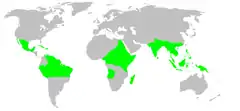| Midget ground weavers Temporal range: | |
|---|---|
| Scientific classification | |
| Domain: | Eukaryota |
| Kingdom: | Animalia |
| Phylum: | Arthropoda |
| Subphylum: | Chelicerata |
| Class: | Arachnida |
| Order: | Araneae |
| Infraorder: | Araneomorphae |
| Family: | Ochyroceratidae Fage, 1912 |
| Diversity | |
| 10 genera, 165 species | |
 | |
Ochyroceratidae is a six-eyed spider family, with 165 described species in ten genera. They are common inhabitants of caves and the tropical forest litter of South Africa, the Caribbean, Asia and South America.[1] Considered an ecological counterpart of the Linyphiidae of the northern temperate zone,[2] species are especially diverse in the Indo-Pacific region.
These spiders build small, irregular sheet-webs in dark, damp places and typically carry eggs in their chelicerae until they hatch. Body length can range from 0.6 to 3.0 millimetres (0.024 to 0.118 in), and some species with very long legs (Althepus, Leclercera) are superficially similar to members of Pholcidae.[2] Differences between males and females are still relatively unknown, but at least one species in the genus Theotima (T. minutissima) was shown to be parthenogenetic.[3]
Genera
As of April 2019, the World Spider Catalog accepts the following genera:[4]
- Dundocera Machado, 1951 — Angola
- Euso Saaristo, 2001 — Seychelles
- Fageicera Dumitrescu & Georgescu, 1992 — Cuba, Colombia
- Lundacera Machado, 1951 — Angola
- Ochyrocera Simon, 1892 — Caribbean, South America, Mexico, Guatemala, Samoa
- Ouette Saaristo, 1998 — China, Seychelles
- Psiloochyrocera Baert, 2014 — Ecuador
- Roche Saaristo, 1998 — Seychelles
- Speocera Berland, 1914 — South America, Africa, Asia, Oceania, Cuba
- Theotima Simon, 1893 — Panama, Mexico, Caribbean, South America, Africa, Germany
- †Priscaleclercera Wunderlich 2017 — Burmese amber, Myanmar, Cenomanian
See also
References
- ↑ Baptista, R.L.C. (2003). "Speocera eleonorae sp. n., the first troglomorphic spider from Brazilian caves (Araneae: Ochyroceratidae)" (PDF). Revista Ibérica de Aracnología. 7: 221–224. Archived from the original (PDF) on 2007-02-21. Retrieved 2006-07-10.
- 1 2 Tong, Yangfeng; Li, Shuqiang (2007). "First records of the family Ochyroceratidae (Arachnida: Araneae) from China, with descriptions of a new genus and eight new species" (PDF). The Raffles Bulletin of Zoology. 55 (1): 63–76.
- ↑ Edwards, G.B. (2003). "Observations of Theotima minutissimus (Araneae, Ochyroceratidae), a parthenogenetic spider" (PDF). The Journal of Arachnology. 31 (2): 274–277. doi:10.1636/0161-8202(2003)031[0274:OOTMAO]2.0.CO;2. S2CID 1705695.
- ↑ "Family: Ochyroceratidae Fage, 1912". World Spider Catalog. Natural History Museum Bern. Retrieved 2019-04-22.
External links